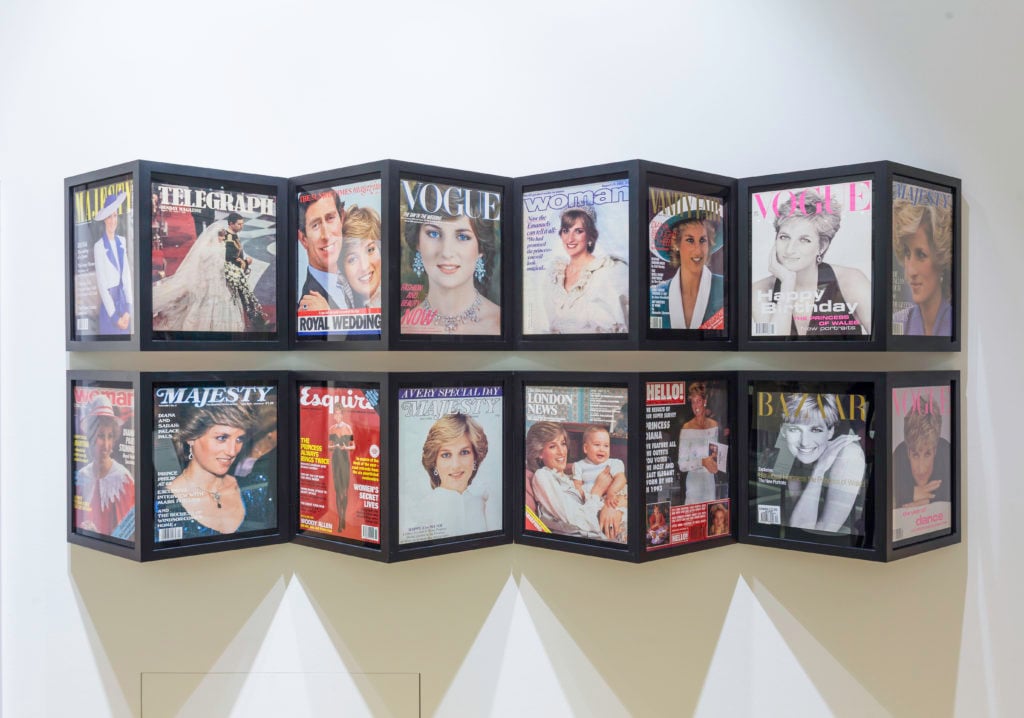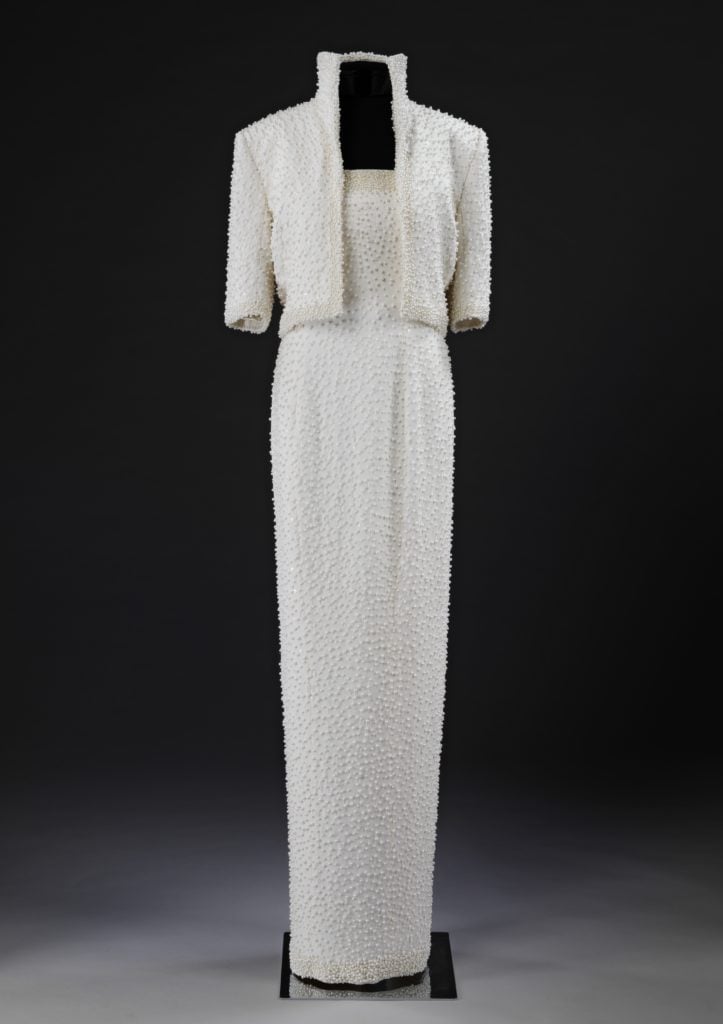Reviews
London Exhibition Tells Princess Diana’s Story Through Fashion—But Where’s Her Wedding Gown?
The new exhibition puts some of Lady Di's most iconic looks on display.

The new exhibition puts some of Lady Di's most iconic looks on display.

Hettie Judah

Perhaps the most remarkable thing about “Diana: Her Fashion Story” is the photograph that accompanies each exhibited frock. Destined for mass consumption, the pictures show the garments as worn by the woman born Diana Spencer. They tell us that what we are looking at has particular significance. These 25 lovingly displayed outfits are not just fashion exhibits, nor treasures from the wardrobe of a mere A-List celebrity: they are props that played a vital role in a much larger narrative, and one which continues to resonate in interesting ways decades on.
Come spring, this exhibition in Diana’s former home of Kensington Palace will be accessed past a white garden that marks the 20 years since her death. Its floral mood is carried through to an opening room full of frilly girlishness—chiffon, ruffles, lace, trailing scarves, off-whites and pastels—a sartorial portrait of Diana the ingénue, the “Shy Di” that first appeared in the media. Yet that demure little-child-lost persona remained a key part of her public image long after she mothballed the dotted blue dress she wore as a debutante. Girlish innocence was a hardworking part of her public relations arsenal every bit as much as her brightly-colored Catherine Walker skirt suits.
Commencing with a family snap of 18-year-old Diana awkwardly posed reading a magazine in her ballgown, and concluding with her tits n’ teeth photo session with Mario Testino in 1997, the exhibition structure is less chronological than thematic. Following “Shy Di” we meet “Sporty Di,” “Caring Di,” “Dynasty Di,” and “Revenge Dress Di,” like a series of niche taxpayer-funded Barbie wardrobe sets, or a proto Spice Girls lineup in which all the members are Posh. (As a sign of the times, it somehow seems significant that 2017 is also the 20th anniversary of Wannabe.)

Installation view of “Diana: Her Fashion Story.” Photo courtesy Historic Royal Palaces London.
The clothes? Some are gorgeous, some dull, some amusingly dated: perhaps the most beautiful is a simple but artfully cut evening gown in bottle green velvet, that, we are solemnly informed, “historians have speculated” carries fingerprints of the young Princes indented in its silken pile. The famous wedding dress is not on show (too big, apparently, and, according to a staffer, “we didn’t want the exhibition focused on one day.”)
Diana’s development of a personal style was assisted to no end by the ceaseless critique of her outfits and figure in the popular press. Did her bum look big in that? Have no fear: the tabloids would be the first to let her (and the public) know. Little wonder the poor woman had an eating disorder.
Decades before Instagram, Diana’s self-image was constructed in terms of being photographed. We can see in these garments that the way she dressed and moved was directed not simply by the gaze but by the lens: there’s a velvet evening ensemble with embroidered panels to the rear, drawing cameras to a side or back view, and a white jacket with a high collar, scintillating inside and out with sequins and pearls, that cast a glow of diffused light onto her face. In this constant consideration of the captured image, in a way we, in our era of contouring and camera phones, all share in her legacy.

“The Elvis Dress” (1989) by Catherine Walker, worn by Princess Diana. Photo ©V&A.
“She was a Princess. She had a style. She did everything with grace and charm,” reads a quote from David Thomas, Crown Jeweller, as if the word “Princess” indicated something more profound than simply being wedded to a Prince. As if “Princess” brought with it a suggestion of intrinsic merit, superior beauty, or moral splendor. In the post-Diana era, the fashion world has certainly lost none of its obsession with inherited aura. They may no longer have a real princess to fawn over, but the glossies of today are awash with the entitled offspring of the rich, famous, and famously rich.
A wall is given over to magazine covers, everything from Woman to Esquire, by way of the Sunday newspaper supplements, Harper’s Bazaar and Vogue. They portray Diana variously as an object of popular fascination, a glamorous star, a respected activist, an empathy figure, and a fashion world insider. In this portfolio of affect, she set a gold standard for the celebrity culture that emerged in her time and evolved in our own.
From Tara Palmer-Tomkinson (a high-society It-girl who rose to fame in the UK in the mid 1990s), through Paris Hilton and the wave of skill-lite stars that expertly played the media, to the inherited advantages of Brooklyn Beckham, Lourdes Leon, Lily Rose-Depp et al, to the template of portmanteau celebrity perfected by actor/mom/activist Angelina Jolie, to the impenetrable public persona constructed around the Duchess of Cambridge, Diana cast a long shadow over the understanding of both the rewards and risks of celebrity.
Captions recalling apparent shock at her decision not to wear gloves while shaking hands with the sick, or a formal hat when interacting with children, by inference describe the wider royal family as wildly out of touch with their subjects. Diana became the acceptable, sympathetic face of an unpopular power structure, and as such, her cautionary echo in our present moment is not her beige-shod daughter-in-law, but the new First Lady of the United States.

Installation view of “Diana: Her Fashion Story.” Photo courtesy Historic Royal Palaces London.
The tale of the maiden held hostage to power has been around as long as there have been beautiful women and power-crazed tyrants with the towers and sea monsters to torment them. Diana, with her talk of the “enemy” and its fear of her as “a strong woman doing her bit” provided an intoxicating update on the story. In our emotional projections of sympathy onto the flinching FLOTUS—whether she merits them or not—it seems we’re desperately looking for a retelling.
“Diana: Her Fashion Story” runs through 2017 at Kensington Palace, London.